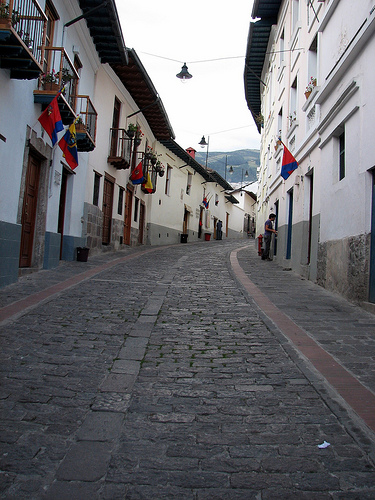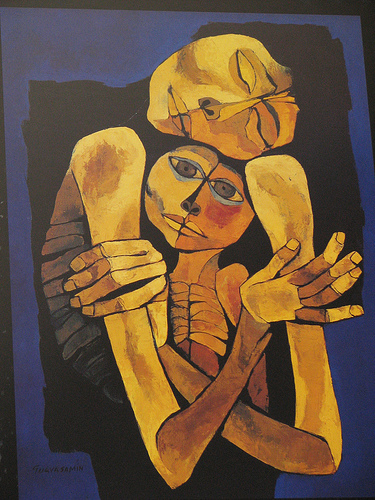
City Focus: Quito – the art of searching for your own identity
17 November, 2010Ecuador’s capital, San Francisco de Quito, better known as Quito, is a treasure in South America. Nestled between Andean mountains, on the foothills of the active Pichincha volcano, the city is the second highest capital city in the world. It offers a splendid view to all the surrounding volcanoes with their snowcapped peaks. But Quito’s best wonder is undoubtedly its historic centre. With about one hundred thirty historical monuments including over eighty churches and monasteries, Quito’s old town, which was declared the first “patrimony of mankind” by UNESCO in 1978, stands as the biggest, most beautiful and authentic colonial centre in the Americas. It’s inspiring beauty has been a muse for many artists throughout the centuries. This year, Quito has been chosen to be the 2011 American Capital of Culture.
Quito, a World Heritage
Quito has been inhabited for thousands of years. It is considered that Quito’s first settlement dates back to the first millennium. It was occupied by the Quitus tribe, who gave name to the city. Translating Centre (“Qui”) of the World (“To”). The tribe was then conquered by the Caras tribe to form the Shyris culture under the Kingdom of Quito. In the 15thcentury, this civilisation was defeated by the Inca Tupac Yunpanqui and the area was incorporated into the Incan Empire. Quito, as it is known today, was officially founded on December 6th, 1534 by the Conquistador Sebastián de Benalcázar on the ruins of the Inca town which had been burned by the Incas themselves.
Right after the arrival of the Spaniards, Quito began forming with the construction of the San Francisco Covent and Church, which is still the most imposing architectural monument of the city, followed by many other religious edifices. The Compañia de Jesús cathedral in Santo Domingo, is one of the most important colonial-styled ones. Seven religious buildings were even built on one single road called “Calle de las siete cruces” (the Street of Seven Crosses) and today renamed Garcia Moreno. The city’s architecture was characterised by a mix of Baroque and Moorish styles. Their interiors were fully decorated with rich elements from the “School of Quito”. This artistic trend was initiated in the Escuela de Artes y Oficios, an art school founded in 1554 by the Franciscan priest Jodoco Ricke, where indigenous artists were trained. This religious-inspired tradition is an expression of the combination and adaptation of European and Indigenous features. It incorporates Spanish, Flemish, Italian, and Moorish influences.
Over the charming city, the Virgin Mary, as an angel, is graciously looking after Quito. The 45-meter high monument, which is composed of about seven thousand aluminiummm pieces, was built in 1976 by the Spanish artist Agustín of the Herrán Matorras, whose work was inspired from a small 18th-century sculpture. This piece of art was made by the “School of Quito” sculptor Bernardo de Legarda and can be found in the San Francisco Church. The giant statue is said to be the only representation of the Virgin Mary with wings in the world. It was erected on top of the Panecillo, the “small bread”. This hill is thought to be formerly called “Shungoloma”, meaning “the Hill of the Heart” in Kichwa, the indigenous language. A temple dedicated to Yavirac, the God of sun was even elevated there.
Downhill, one can find La Ronda, one of the oldest and emblematic streets of Quito. It was the heart of the bohemian city, where all the painters, writers, singers and other artists used to live. The narrow street, which was neglected for years, was finally restored in 2006 and is once again the heart of Quito’s artistic life with its art workshops, galleries and street artists.
La Ronda (photo by Phillips Barron)

Painting misery and oppression
Oswaldo Guayasamin is the most famous and recognised Ecuadorian artist of the 20th century. He dedicated his life to denouncing the human misery, poverty, pain, political oppression, atrocities of war and racism people endure in South America – and more generally in the world – through his paintings and sculptures. The humanist expressionist artist specialised in capturing images of ugly, tortured faces and other human feelings in an overwhelming and amazing way. He painted maternal love as well as his love for Ecuador and its people. He also expressed Latin American identity through its diversity and culture. His major works are Huaycayñan (trail of tears), including one hundred paintings and La Edad de la Ira (the age of anger), composed of two hundred pieces of art. He also achieved murals that can be found in Quito such as El descubrimiento del Río Amazonas (the discovery of the Amazon River) in the “Palacio del Gobierno” (government house).
Ternura by Guayasamin (photo by Michael Sandoval)

Guayasamin was born in Quito on July 6th, 1919 from a poor family. His father was indigenous and his mother a “mestiza”, both of Kichwa descent. The artist started painting during his childhood. He graduated from the School of Fine Art in Quito in 1941 and held his first exhibit when he was 23, in 1942. The following year he travelled to the U.S. and throughout Latin America where he observed the indigenous life condition featured in his paintings. He received many awards for his work including the first prize at the Third Hispano-American Biennial of Art in Barcelona, Spain in 1955. In 1957, he was named the best South American painter at the Fourth Biennial of Sao Paulo, Brazil.
In Quito, a major part of his work can be found in the Guayasamin Foundation, where Ecuadorian archaeologicalll treasures he collected all his life are also exhibited, and in La Capilla del Hombre (The Chapel of Man), his last masterpiece. He died on March 10th, 1999 at the age of 79 years old. He was buried under the majestic “tree of life” in the garden of his house, close to The Chapel, with his friend, the great Ecuadorian poet Jorge Enrique Adoum.
Jorge Enrique Adoum, in love with Quito
Jorge Enrique Adoum was an Ecuadorian poet, writer, politician and diplomat. He is considered to be an icon in modern Latin American literature. He was part of the Ecuadorian literary group known as “Madrugada”. His predominant concern was Latin American social and political reality. He evoked Ecuador as well as denounced centuries of exploitation. He also worked as a translator, was an Ecuadorian representative for UNESCO and a journalist all around the world.
He was born in the Ecuadorian town of Ambato on June 29th, 1926 from a Lebanese father, Jorge Elías Francisco Adoum who was a translator, artist, writer and practised natural medicine. As a child, he moved to Quito. He studied law and philosophy there and fell in love with the city. He finished his studies in Santiago de Chile where he met the poet Pablo Neruda and became his personal secretary at the age of nineteen. According to the Chilean poet, Jorge Enrique Adoum was the best poet in Latin America. Among other prizes, he won the Mexican Premio Xavier Villaurrutia in 1976 for one of his most famous works, Entre Marx y una mujer desnuda (Between Marx and a Woman Undresses).
All his life, Adoum considered himself a Quitenian and was deeply proud of it. He loved everything of the city¡ its people, its lifetime, its architecture… But he was aware that Quitenians suffered from a complex: “we don’t accept who we are, that we are mestizos […]. There is a noticeable and beautiful richness in this mix, in these features but we are not able to find reasons for pride and identity to give us dignity. For this reason, it is good to feel Quitenian”. Adoum died on July 3rd 2009, at the age of 83 years old, in Quito, where he always wanted to rest.
Follow Sounds and Colours: Facebook / Twitter / Instagram / Mixcloud / Soundcloud / Bandcamp
Subscribe to the Sounds and Colours Newsletter for regular updates, news and competitions bringing the best of Latin American culture direct to your Inbox.

